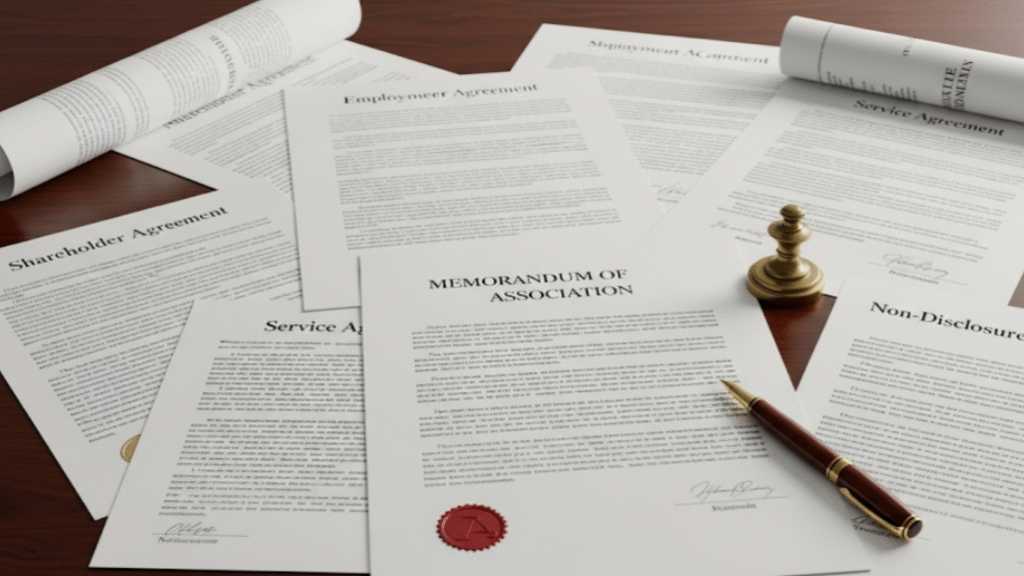Introduction:
“Strong agreements today prevent disputes tomorrow.”
Every handshake in the business world needs to be supported by a legally valid contract. Written contracts are essential for outlining rights and obligations when forming a partnership, employing suppliers, or working with another business. Businesses frequently fail to create the appropriate agreement type for the transaction or mistake an agreement with a Memorandum of Understanding (MoU). This can lead to conflicts, financial losses, or even loss of legal rights.
Agreement vs. MoU: What’s the Difference? (you can download sample Agreement and MOU at the end of this articale)
Agreement:
An agreement is legally enforceable provided it satisfies the requirements of the Indian Contract Act, 1872, which include offer, acceptance, consideration, and the desire to establish legal relations.
Example: A supplier agreement where both parties commit to specific terms.
MoU (Memorandum of Understanding):
An MoU is usually non-binding and mainly records the intention of parties to cooperate or continue discussions. Early on in contracts, partnerships, or joint enterprises, it is commonly used. However, if it is clear from the wording that legal obligations are intended, an MOU may also be enforceable in court.
Businesses should always prepare a proper agreement before finalizing any transaction. In an MoU, avoid vague or conflicting terms, since courts may interpret them in unexpected ways.
Types of Agreements Businesses Commonly Use
1. Commercial Agreements
The purpose of commercial agreements is to define business-to-business (B2B) relationships. To avoid disputes, they should clearly mention delivery timelines, quality standards, payment schedules, and methods for resolving disputes
Examples: Vendor contracts, franchise agreements, supply contracts.
2. Employment & Service Agreements
These agreements govern relationships between employers and employees, as well as companies and consultants. Incorporate noncompete, confidentiality, and IP ownership agreements at all times. When workers depart with commercial secrets or client information, many conflicts result.
Examples: Employment contracts, consultancy agreements, service level agreements (SLAs).
3. Partnership & Shareholder Agreements
Its purpose is to regulate the responsibilities and rights of investors and partners. Exit clauses, valuation techniques, and decision-making authority should always be included. Many companies face lawsuits because they ignore these key aspects in the beginning.
Examples: Partnership deeds, joint venture agreements, shareholder agreements.
4. Property & Lease Agreements
Its aim is to control immovable property ownership, tenancy, and usage. Where required, agreements must be registered under the Registration Act, 1908 to be legally valid. Courts frequently rule that unregistered property agreements are invalid.
Examples: Lease deeds, licensing agreements, sale agreements.
5. Technology & IP Agreements
Its goal is to safeguard creative works, patents, code, and innovation. Clearly define ownership and usage rights in the draft. Unless a clear assignment is documented, courts frequently find in favour of the author.
Examples: Software licensing, technology transfer, intellectual property assignment.
6. Loan & Investment Agreements
Its goal is to specify financial and payback commitments. Incorporate security, interest rates, and default provisions at all times. Poorly drafted repayment terms often cause investors to lose money.
Examples: Loan agreements, convertible note agreements, investment term sheets.
7. Non-Disclosure Agreements (NDAs)
NDAs are designed to protect sensitive business information exchanged between parties. Startups and companies often need to disclose details such as customer databases, source codes, financial records, or business strategies. Without an NDA, this information can be misused or leaked.
A well-drafted NDA should clearly define what constitutes confidential information, the period of confidentiality, and the legal consequences of a breach. NDAs can be one-sided (where only one party shares information) or mutual (where both parties exchange confidential data).
Examples:Investor discussions, vendor relationships, technology development, mergers & acquisitions.
Common Mistakes Businesses should avoid while drafting Agreements
- Not taking Indian law into account while using generic web templates.
- Ignoring registration or stamp duty, which weakens contracts legally.
- Clauses that are ambiguous and open to several interpretations.
- Ignoring arbitration or jurisdiction terms in dispute resolution agreements.
- Not updating contracts as business conditions or regulations change.
How to Avoid Legal Risks
- Ensure agreements are properly stamped and registered under applicable laws.
- Use clear, simple language instead of complex legal jargon.
- Regularly review and update contracts to align with business growth and compliance needs.
- Always have a dispute resolution strategy—arbitration, mediation, or litigation jurisdiction.
- Engage a commercial lawyer at the drafting stage rather than during a dispute.
Conclusion
Treat every agreement as a shield for your business. Agreements and MoUs are not just paperwork—they are the backbone of business transactions. An MoU records intent, but a well drafted agreement ensures enforceable rights and obligations. Businesses that invest in strong contracts minimize litigation risks, save costs, and build stronger partnerships.
FAQs
Q1: Is a MoU legally binding in India?
Not always. It depends on how it is drafted. If rights, duties, and consideration are included, courts may enforce it. Otherwise, it’s only a statement of intent.
Q2: Do Agreements always need to be registered?
Not all. For example, simple service agreements don’t. But agreements like lease deeds (beyond 11 months) or property transfer must be registered under the Registration Act, 1908.
Q3: Can a MoU replace a contract?
No. A MoU is generally a precursor to a contract. For enforceability, always execute a proper agreement.
Q4: Which is safer for business—MoU or Agreement?
Agreements are safer since they are legally binding. MoUs are useful at the discussion stage.
Q5: Can MoUs be challenged in court?
Yes, but only if they have enforceable terms. Otherwise, courts usually treat them as non-binding.
